[ad_1]
I’ve just visited a narrow north facing garden with some charming thin garden ideas and a wildlife friendly focus.
It’s also on a slope – so the garden conditions could be considered challenging. Yet Richard and Jacqui Drew make the most of their shady garden. It’s full of inspiration for anyone who loves gardens.
Richard and Jacqui have several pretty seating areas around the garden, echoing the blue colour theme.
After all, many of us have a north facing or shady border, an area of slope or a narrow strip of garden. So I asked Richard for his tips.
Their house is a Victorian terraced house, and the garden is around 100ft long, with varying width. It’s 18ft wide near the house and tapers to just 10ft wide at the end of the garden.
Quick top tips for a north facing garden:
- Shady gardens can be mainly green. Add colour via furniture, pots and the doors and windows of your house.
- Blur the boundaries. Don’t try to increase the light by cutting down all trees. Trees lead the eye upward and distract from the size of the garden. They offer extra planting space and wildlife habitat.
- You can add some light by pruning out lower branches of taller trees.
- No lawn. In a small north facing garden, a lawn may not do well. Use gravel, pavers or extra wide borders instead.
- Choose plants that are recommended for shade. But experiment with a few others.
- Have seating areas around the garden. One or more spots will get sun at some point in the day.
- Find out more below…
Colour theme doors, windows, pots and pavers
There are lots of plants that flower in the shade, but north facing gardens and shady borders are often mainly green. Many of the really colourful flowers prefer full sun.
So Richard and Jacqui have a very pretty colour scheme based on a soft shade of blue-grey. They used International Floor Paint in ‘Granite Grey’ on the pavers, but it was discontinued. So they now use Wilko’s own brand Floor Paint. ‘It’s not recommend for outdoor use, but it seems to cope well,’ says Richard.
They’ve painted doors, window frames, pots and even pavers in similar shades. I visited on a drab, drizzly day. The garden felt light and colourful in spite of the weather.

Richard and Jacqui have painted window frames, door frames, pots and pavers all in this very attractive shade of blue. It makes the garden feel light and colourful.
They didn’t like their back terrace pavers, but instead of replacing them completely, they took some out and replaced them with gravel. And then they painted other pavers in the signature blue colour with marine paint. It really pulls the back area together.
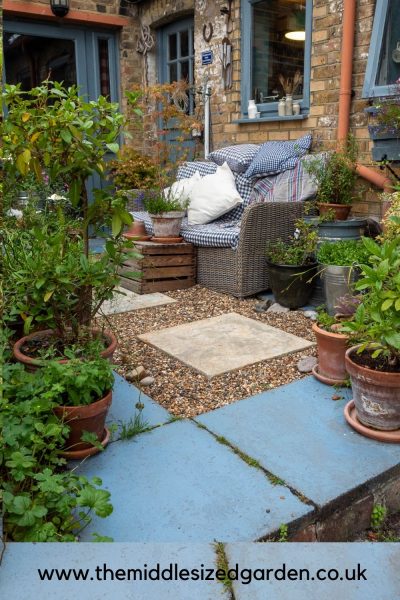
If you don’t like your pavers, paint them!
And having a mix of gravel and pavers is also more environmentally friendly because water soaks into the soil in heavy rain instead of rushing into the drainage system. Plus, of course, re-using and adapting pavers rather than buying new is also more sustainable.
No lawn for a north facing garden
This depends on the size of your garden. If you have a larger garden, then lawn should be fine.
But if you have a small shady area, it is very difficult to keep a lawn looking good. Richard and Jacqui gave up trying to grow a standard lawn in the narrow strip of shade behind their house.

Instead of lawn, Richard and Jacqui used a mix of different sized gravel and stones, giving a sunny Mediterranean feel to the shady north facing garden area. They’ve created a gravel ‘stream’ by using a different shade to mimic water trickling down to one of the mini ponds.
Instead they have covered it with gravel and added planting. It has a Mediterranean look to it and makes the area look lighter.
They’ve also done a clever pattern with contrasting gravel. There are several mini ponds in the garden, and they have used a trickle of grey stone and gravel to mimic a stream going down to one of the ponds.

A small pond tucked in beside the path hosts newts.
It’s worth noting that it’s harder to mow a lawn on a slope, too. And if you have a smaller garden, then it’s sometimes difficult to find the space to store even a small mower.
Richard and Jacqui’s garden is designed to be as wildlife friendly as possible. If they had paved over their lawn completely, that would not have been environmentally friendly or helpful to wildlife. Hard surfaces lead to run off in heavy rain. And concreting over an area or covering it with fake lawn is not helpful to the micro-organisms in the soil.
But gravel, intermittent pavers or planting all leave the soil healthy for worms and micro-organisms. It will maintain good drainage.

No mower – so Richard and Jacqui can keep garden equipment in a small shed, which they’ve painted in the signature blue.
Space saving hedging
Richard and Jacqui have been following the Kent Wildlife Trust’s advice on creating a wildlife friendly garden for several years now. Last year, they won a Gold award for wildlife friendliness.
Each year the Kent Wildlife Trusts visits private gardens that have put themselves up for the award. They make recommendations and award levels, such as Bronze, Silver and Gold.
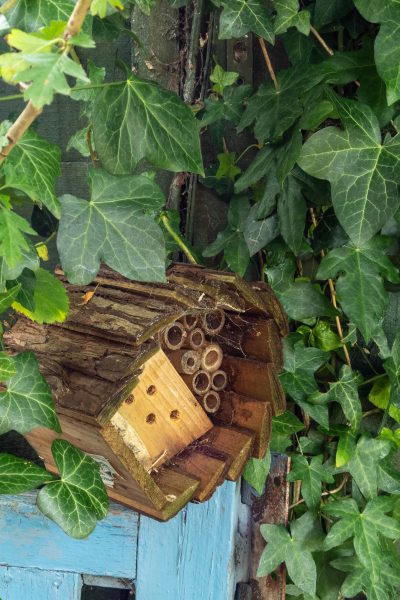
One of Richard and Jacqui’s ten bug hotels, hung on blue painted wood.
And one of the principles of a wildlife friendly garden is that hedging is better than fences or walls. Hedges offer shelter and food to a wide range of birds and insects. However, some hedges take up quite a bit of space.
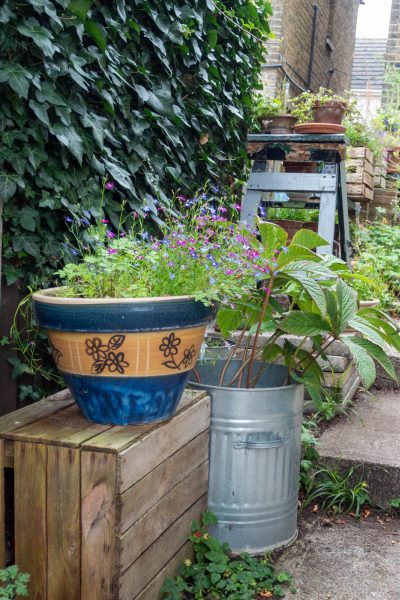
An ivy hedge grows well in a shady or north facing garden. It provides food and shelter for wildlife and is less bulky than many hedging shrubs.
Ivy grows well in shady gardens. So Richard and Jacqui have an ivy hedge, which grows over the fence and completely conceals it. Ivy can grow rampant – Richard is about to give this ivy hedge a good cutting back. However, even when it’s grown too much, it takes up less space than a shrub-based hedge.
And ivy offers more shelter, flowers and berries than a fence or wall.
Embrace the shade and blur the boundaries
Some advice suggests that you should clear away all trees in a north facing garden, in order to maximise the light. But in a narrow north facing garden that will expose the boundaries. And if you’re in a town you’ll lose privacy.
You will add a little light, but the difference probably won’t be worth it. After all, you can’t change where the sun lands.
Fences and walls create hard lines around the edge of your garden. They emphasise the boundaries, so you can see where your garden starts and ends immediately. This can make a thin garden feel like a small, narrow box.

You can’t see where Richard and Jacqui’s garden starts or stops. Green boundaries and vertical interest with trees make the garden seem wider and more lush.
Instead, trees take the eye upwards, and give you extra planting space. You stop looking at the boundaries and start to enjoy the view. Jacqui and Richard have fruit trees, which they share with the birds.
Shrubs, planting and hedges can also achieve the same effect, especially if there is planting in neighbours’ gardens or trees on the other side of the boundary.
I thought their garden was much longer than it is, because it’s not clear where it ends. There are hawthorn trees on the other side of their property, so Richard planted one on his side.

A path disappears into trees – is there more garden beyond? Having a dark fence and the same kind of tree on both sides of it make it difficult to see where the garden ends.
Of course, adding trees to a north facing garden makes it more shady – but it would have been shady anyway. Having the same planting on both sides of the fence deceives the eye into thinking the garden continues beyond the boundary.
They have also painted the fence dark, so it disappears against the trees. Even when you are right at the end of the garden, it still feels as if it could go on forever.
Trees and a north facing garden
You can, however, increase the light to some extent by pruning away the lower branches of larger trees. Richard and Jacqui have a huge ornamental cherry just behind the house.
They got a tree surgeon to prune away the lower branches and Richard now snips off any new growth that appears.
Have different seating areas – find the sunny spot
Even if your garden is north facing, there will be one or more spots where you can catch the sun.

A bench in the south-facing front garden is positioned to catch the sun. As well as gravel and sun-loving plants, they also leave out a few slates which warm up on sunny days. Lizards love to sunbathe on them.
Richard and Jacqui have created a pretty seating area in the front garden. And another on the back terrace, with two in sunnier spots further down the garden. Throws and cushions add colour to the garden, as do pots.

There are sofas with throws and cushions on the terrace outside the back door – one of four seating areas in the garden. The boxes are a pretty and practical way of stopping the pots from blowing off the wall or being knocked off by their cats.
Choose plants that do well in shade
As well as the ivy, Richard has found which plants do well in his north facing garden through trial and error. Hardy geraniums grow happily in the shade, as do foxgloves. Buddleia can spread a bit too much but is very resilient about where it grows. ‘And lobelia will grow anywhere,’ says Richard, who has lots of blue lobelia in pots echoing the blue paintwork.

Blue lobelia will grow happily in shade and looks great with the colour scheme.
There is something in flower all year round, explains Richard. In spring, there are celandines, hawthorn and primroses. Bluebells, alliums and foxgloves take over. Plants lasting until autumn include penstemons, persicarias and salvias. Ivy flowers from September to November, followed by Winter Jasmine and Viburnum bodnantense.
If you have a north facing garden, start with plants that are labelled as suitable for shade or partial shade. But experiment, too. Sometimes plants will grow where they shouldn’t. For example, there is some vipers bugloss in the back garden, which is usually happiest in full sun.
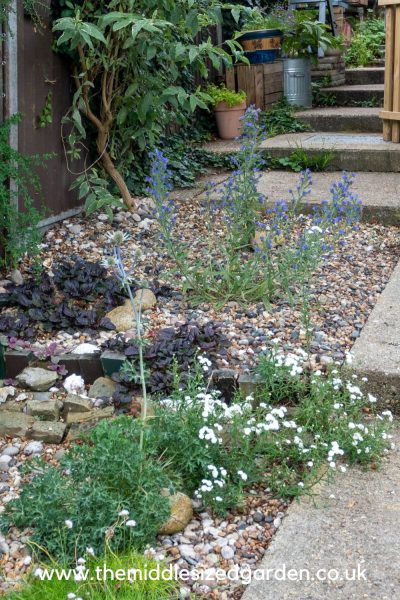
The blue flower in this gravel area is viper’s bugloss, usually a sun lover. But it seems perfectly happy here in a north facing garden. It’s often a question of experimenting to see if plants will like it in your garden.
Several mini ponds instead of one big one
Water is the most important thing for a wildlife friendly garden. A narrow north facing garden, on a slope, doesn’t have an obvious place for a pond. So Richard and Jacqui have dug two mini ponds into the ground.
One is visited by newts and the other is favoured for frogspawn. The frogs like the shade so Richard built a little bridge over the pond to shade it further.
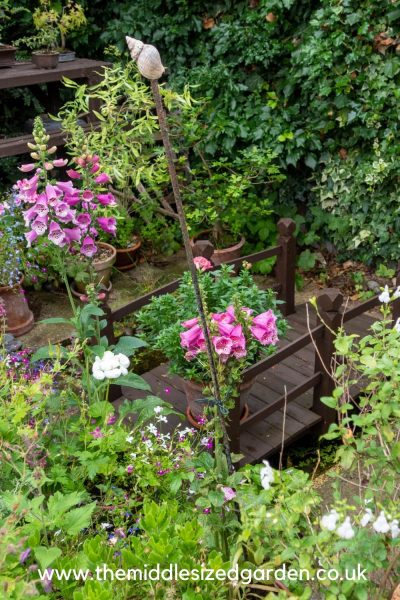
One of two tiny ponds dug into the garden. This one has a mini bridge over it, because the frogs seem to like shade for their frogspawn.
They haven’t introduced any wildlife. ‘If you create the right conditions, the creatures will just turn up,’ says Richard. They have hedgehogs, bats, newts, stag beetles, frogs, toads, lizards and more – ‘I haven’t seen the toads this year, but I can hear them,’ he says.
They also have three mini ponds in oak barrels. Having water in different places gives creatures a chance to drink and bathe safely. One of the oak barrels is in the front garden. You can find out more about how to make a mini wildlife pond in an oak barrel here.

One of three mini ponds in a barrel.
Mini ponds in a sunny spot can dry out easily in a heatwave, which would be dangerous to any creatures that live in the water. Because it is a north facing garden, that’s less likely to happen. But it’s still important to make sure that ponds don’t empty in dry weather.
Bug hotels, bat boxes and bird feeders
The Kent Wildlife Trust advised Richard that if he made his garden friendly to insects, then the birds would come. There are 10 bug hotels around the garden, plus bat boxes, two or three bird houses and log piles.
At the steepest part of the slope, they have added a log pile. It helps stop soil being washed down by rain. And as it slowly decays, it offers a home to stag beetles. Richard adds a couple of logs every year. Stag beetle larvae munch wood and can take three to seven years to pupate.

One of Richard and Jacqui’s ten bug hotels.
More about garden design
Other useful posts on garden design for smaller gardens include How to save money on garden design and Take An Insider Look at the Essentials of Garden Design.
More about wildlife gardens
If you’d like to make your garden more wildlife friendly, see what makes a good wildlife garden, 12 easy ways to help wildlife in your garden now, how to make a mini meadow and how to plant a butterfly garden.
And I have some wildlife friendly book and product recommendations on the Middlesized Garden Amazon store. Note that links to Amazon are affiliate, which means I may get a small fee if you buy. But it doesn’t affect the price you pay and I only recommend things I’ve tried myself and think you will like.
Richard and Jacqui’s garden is often open for Faversham Open Gardens & Garden Market Day, which usually takes place on the last Sunday in June.
Pin to remember north facing garden tips
And do see here to join us on the Middlesized Garden every Sunday morning for more tips, ideas and inspiration for your garden.
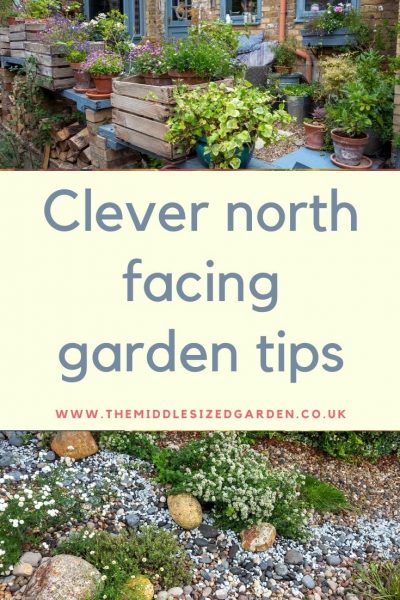
[ad_2]
Source link
